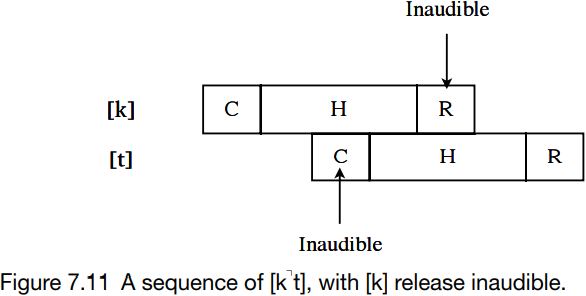
Inaudible release
 المؤلف:
Richard Ogden
المؤلف:
Richard Ogden
 المصدر:
An Introduction to English Phonetics
المصدر:
An Introduction to English Phonetics
 الجزء والصفحة:
113-7
الجزء والصفحة:
113-7
 13-7-2022
13-7-2022
 2636
2636
Inaudible release
Sometimes plosives have no audible plosion. Inaudible release is marked with the diacritic  .
.
This can arise when one stop closure is made, then another: the second one masks the release of the first, while the hold of the first masks the transition into the closure of the second.
This is well illustrated in words with plosive + plosive clusters, such as ‘tact’ and ‘apt’. There are two possibilities for the first of the plosives in the [kt] and [pt] clusters. The first is that the plosive is released, so that two distinct plosive portions are heard: [takt apt] (Figure 7.10).

The second possibility is that the first plosive of the cluster is inaudibly released; in this case, closure into velarity or labiality is heard in the vowel. Once the dorsal or labial closure is achieved, the alveolar one is made; and when the alveolar closure is achieved, the first closure is released (Figure 7.11). In the case of a velar + alveolar sequence, the velar closure is behind the alveolar one, so nothing will be heard. In the case of a labial + coronal sequence, the amount of air between the two closures is very small, and release of the labial closure may generate a percussive sound (i.e. just the sound of the articulators coming apart), but there will be insufficient air pressure in the cavity between the lips and coronal closure to produce a plosive release. The release is then made into alveolar plosion. The whole sequence can be transcribed as  .
.

The third possibility is a common way to end utterances where the speaker has no more to say: most notably, word forms like ‘yep’,  , and ‘nope’,
, and ‘nope’,  , for ‘yes’ and ‘no’ are not produced with audible release. One likely explanation for these kinds of forms is that they end with labial closure, which is visible: a mouth that is closed is a mouth that is not talking. By making a bilabial closure, the ‘completed’ nature of the utterances that end this way is highly visible.
, for ‘yes’ and ‘no’ are not produced with audible release. One likely explanation for these kinds of forms is that they end with labial closure, which is visible: a mouth that is closed is a mouth that is not talking. By making a bilabial closure, the ‘completed’ nature of the utterances that end this way is highly visible.
 الاكثر قراءة في Phonetics
الاكثر قراءة في Phonetics
 اخر الاخبار
اخر الاخبار
اخبار العتبة العباسية المقدسة


